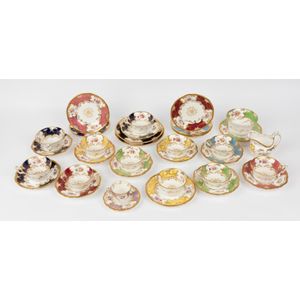Harlequin Coalport Tea Set with Floral and Gilded Design
A large Harlequin Coalport afternoon tea service, early 20th century, comprising approximately thirty pieces, decorated in pattern 2265 with floral sprays and gilded gadrooned borders, factory marks to the base, including a miniature teacup, the milk jug 9 cm high
You must be a subscriber, and be logged in to view price and dealer details.
Subscribe Now to view actual auction price for this item
When you subscribe, you have the option of setting the currency in which to display prices to $Au, $US, $NZ or Stg.
This item has been sold, and the description, image and price are for reference purposes only.
- Gadrooning - A series of lobes usually as a border. In furniture gadrooning is found as carved decoration around the edges of table tops in the Chippendale and Jacobean style furniture. Gadrooning is also found as decoration on the rims of silver and ceramics.
- Harlequin - The Harlequin is a character from the Italian commedia dell'arte, a form of theatre typified by characters wearing masks, and acting out unscripted performances. There are corresponding characters in the French and Spanish theatre.
In dress, he is characterised by his hat, mask, and colourful diamond-pattern tunic.
Columbine is the mistress of Harlequin, and the wife of Pierrot. - Gilding - Gilding is a method of ornamentation whereby a thin sheet of gold metal is applied to items made of wood, leather, ceramics, glass and silver for decorative purposes.
For furniture including mirrors, the sheet of gold is usually applied over a coating of gesso. Gesso is a mixture of plaster of Paris and gypsum mixed with water and then applied to the carved wooden frames of mirrors and picture frames as a base for applying the gold leaf. After numerous coats of gesso have been applied, allowed to dry and then sanded a coat of "bole", a usually red coloured mixture of clay and glue is brushed on and allowed to dry, after which the gold leaf is applied. Over time parts of the gilding will rub off so the base colour can be seen. In water gilding, this was generally a blue colour, while in oil gilding, the under layer was often yellow. In Victorian times, gilders frequently used red as a pigment beneath the gold leaf.
Metal was often gilded by a process known as fire gilding. Gold mixed with mercury was applied and heated, causing the mercury to evaporate, the long-term effect of which was to kill or disable the craftsman or woman from mercury poisoning. The pursuit of beauty has claimed many victims, not the least of which were the artists who made those pieces so highly sought after today.
This item has been included into following indexes:
- Coalport and Coalbrookdale porcelain (England) - ceramics 518
- Coalport porcelain (England), item type
